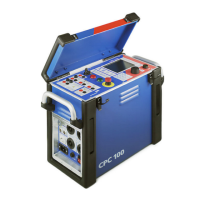CPC 100 V 3.20
Current Transformer - 5
During the test, the test voltage increases in a ramp characteristic from 0 V to Vtest. Vtest is
then applied to the output for the specified time span. The measurements are continuously
taken. Afterwards, Vtest decreases in a ramp characteristic.
Use the PolCheck test card to check a series of test points for correct polarity.
To do so, the CPC 100 injects a special polarity test signal at a certain location. This signal can
either be a voltage or a current signal from the CPC 100, and has a signal characteristic similar
to a saw-tooth signal with a different steepness for the rising and the falling slope.
The polarity check itself is then done with the CPOL accessory, a portable easy-to-use polarity
checker.
DANGER
Death or severe injury caused by high voltage or current
► Do not touch the terminal connected to the transformer’s secondary connection
“1S1”, it carries life-hazardous voltage.
Nominal test voltage
(2kV max.)
Terminates test when current
threshold is reached
Output frequency
Terminates test when testing
time has elapsed
Actual test voltage
Time span Vtest is applied to the
output
Highest measured current
Actual test current
If the CPOL detects the same signal characteristic at a test point, it considers the
polarity as OK, and lights up the green LED.
If the signal characteristic is inverted or distorted, the CPOL considers the polarity
not OK, and lights up the red LED.
If the CPOL detects a signal that is too low, both LEDs light up at the same time.
Remedy: increase the signal magnitude.
If the capacity of the CPOL’s battery gets low, the LEDs start flashing. As long as
the LEDs are flashing, the CPOL’s battery provides sufficient power to continue
working. However, the battery should be changed as soon as possible.
DANGER
Death or severe injury caused by high voltage or current
► Never operate the CPOL with an open battery compartment. A life-hazardous
voltage level may occur in the battery compartment if the CPOL’s probe touches a
test point with high-voltage potential!
► Handle with extreme caution: Do not touch the test point with your fingers.
► If you detect a wrong polarity in the current path, turn off the CPC 100 first, and only
then disconnect the terminals.

